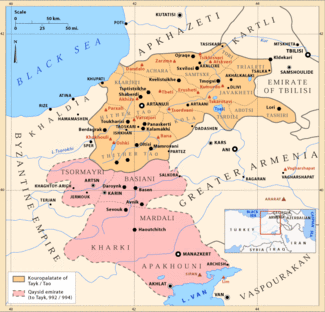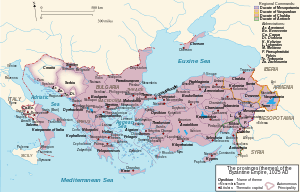Iberia (theme)
The theme of Iberia (Greek: θέμα 'Ιβηρίας) was an administrative and military unit – theme – within the Byzantine Empire carved by the Byzantine Emperors out of several Georgian and Armenian lands in the 11th century. It was formed as a result of Emperor Basil II’s annexation of a portion of the Bagrationi Dynasty domains (1000–1021) and later aggrandized at the expense of several Armenian kingdoms acquired by the Byzantines in a piecemeal fashion in the course of the 11th century. The population of the theme—at its largest extent—was multiethnic with the Armenian majority, including a sizable Armenian community of Chalcedonic rite to which Byzantines sometimes expanded, as a denominational name, the ethnonym "Iberian", a Graeco-Roman designation of Georgians.[1][2][3] The theme ceased to exist in 1074 as a result of the Seljuk invasions.
Foundation and enlargement

The theme was created by the emperor Basil II (976-1025) from the lands inherited from the Georgian prince David III of Tao. These areas – parts of the Armeno-Georgian marchlands centered on Thither Tao / Tayk as well as several northern districts of western Armenia including Theodosioupolis (Karin; now Erzurum, Turkey), Basean, Hark’, Apahunik’, Mardali (Mardaghi), Khaldoyarich, and Ch’ormayari – had been granted to David for his crucial assistance to Basil against the rebel commander Bardas Sclerus in 979. However, David’s rebuff of Basil in Bardas Phocas’ revolt of 987 evoked Constantinople’s distrust of the Caucasian rulers. After the failure of the revolt, David was forced to make Basil II the legatee of his extensive possessions.[1]
Basil gathered his inheritance upon David’s death in 1000, forcing the successor Georgian Bagratid ruler Bagrat III to recognize the new rearrangement. Bagrat’s son, George I, however, inherited a longstanding claim to David’s succession. While Basil was preoccupied with his Bulgarian campaigns, George gained momentum to invade Tao/Tayk and Basean in 1014. Defeated in the ensuing Byzantine-Georgian wars, George had to relinquish further lands – Kola, Artaan and Javakheti – to the Byzantine crown in 1022.[4] These provinces were organized by Basil II into the theme of Iberia with the capital at Theodosiopolis. As a result, the political center of the Georgian state moved north, as did a significant part of the Georgian nobility,[5] while the empire gained a critical foothold for further expansion into the territories of Armenia and Georgia.

Basil next claimed the principal Armenian Bagratid kingdom of Ani, currently straddling the division between Gagik I’s sons, John-Smbat and Ashot I. In 1022, John-Smbat, as penalty for having supported Georgia, yielded his appanage to the Byzantine Empire. By the mid-1040s, Emperor Constantine IX (1042-55) had broken the resistance of the survived Bagratids of Ani and forced the catholicos Peter into surrendering Ani in 1045.[6] The kingdom was merged with the theme of Iberia and the capital was transferred from Theodosioupolis to Ani. Henceforth, the theme of Iberia was administered jointly with Greater Armenia and the enlarged theme was frequently referred to as the "theme of Iberia and Armenia".[7]

In 1064 the last independent Armenian kingdom, that of Kars, was absorbed into imperial territory when Gagik II of Kars was bullied into abdication in favor of Emperor Constantine X (1059–67) to prevent his state from being conquered by the Seljuk Turks. The royal family moved to Cappadocia, probably accompanied by their nobility who were inveigled by the Byzantine administration into ceding their estates in return for lands further west.[6] The event was preceded by the Seljuk capture of Ani and the theme’s center was shifted back to Theodosioupolis.[8]
Government

The exact chronology of the theme of Iberia and of its governors is not completely clear. Unfortunately, the few Greek seals from the theme or from the ambiguous "Interior Iberia" can seldom be dated precisely.[7] Although many scholars maintain that the theme was probably created immediately after the annexation of David of Tao’s princedom, it is difficult to ascertain whether Byzantine rule extended into Tao and Tayk permanently in 1000 or only after Georgia’s defeat in 1022. It is also impossible to identify any commander in Iberia before the appointment, in 1025/6, of the eunuch Niketas of Pisidia as the doux or katepano of Iberia. Some scholars believe, however, that the first doux of Iberia was either Romanos Dalassenos or his brother Theophylactos appointed between 1022 and 1027 in the aftermath of Basil’s Georgian campaigns.[9] Since 1071 Gregory Pakourianos was a governor of the Theme of Iberia.
The Iberian governor was aided by tax officials, judges, and by co administrators who shared in the exercise of the military and civil duties. Among these officials were the domesticos of the East, the administrators of the districts of which the theme was composed, and the occasional extraordinary legates sent there by the emperor. Apart from the regular Byzantine garrisons, an indigenous army of peasant soldiers guarded the area and received in turn an allotment of tax-free government land. This changed, however, when Constantine IX (1042–1055) dismantled the army of the theme of Iberia, perhaps 5,000 men, converting its obligations from military service to the payment of tax. Constantine dispatched Nikolaos Serblias to conduct an inventory and to exact taxes that had never been demanded previously.
End of the Theme
Constantine’s reforms caused great discontent in the theme and exposed it to hostile attack aided by the removal of regular troops from the region, first to crush the Macedonian revolt of Leo Tornicius, himself the former catapan of Iberia (1047),[10] and later to halt the Pecheneg advance.
In 1048-9, the Seljuk Turks under Ibrahim Yinal made their first incursion in this region and clashed with a combined Byzantine-Armenian and Georgian army of 50,000 at the Battle of Kapetrou on September 10, 1048. During this expedition, tens of thousands of Christians are said to have been massacred and several areas were reduced to piles of ashes. In 1051/52, Eustathius Boilas, a Byzantine magnate who moved from Cappadocia to the theme of Iberia, found the land "foul and unmanageable... inhabited by snakes, scorpions, and wild beasts."[7]
The theme of Iberia did not long survive the Byzantine disaster at the hands of the Seljuk sultan Alp Arslan at Manzikert, north of Lake Van, on August 26, 1071. Still, it may have lasted as late as 1074 when Gregory Pakourianos, a Byzantine governor, formally ceded a portion of the theme including Tao / Tayk and Kars to King George II of Georgia. This did not help, however, to stem the Turkish advance and the area became a battleground of the Georgian-Seljuk wars.[7]
See also
- Byzantine–Georgian wars
- Byzantine–Seljuq Wars
References
- ↑ 1.0 1.1 Rapp, Stephen H. (2003), Studies In Medieval Georgian Historiography: Early Texts And Eurasian Contexts, p. 414. Peeters Bvba ISBN 90-429-1318-5.
- ↑ Арутюновой – Фиданян, В. А. Типик Григория Пакуриана. Введение, перевод и комментарий. Ереван, 1978, с. 249.
- ↑ Garland, L. (2006). Byzantine Women: Varieties of Experience 800-1200. Ashgate. p. 92. ISBN 9780754657378. Retrieved 2015-04-13.
- ↑ Lang, David Marshall (1966), The Georgians, pp. 109-110. Praeger Publishers.
- ↑ Edwards, Robert W. (1988), The Vale of Kola: A Final Preliminary Report on the Marchlands of Northeast Turkey, p. 126. Dumbarton Oaks Papers, Vol. 42.
- ↑ 6.0 6.1 Redgate, Anne Elizabeth (1998), The Armenians, pp. 226-7. Blackwell Publishing ISBN 0-631-22037-2.
- ↑ 7.0 7.1 7.2 7.3 Edwards (1988), pp. 138-140
- ↑ "Karin" in: Strayer, Joseph Reese (1983), Dictionary of the Middle Ages, p. 215. Scribner, ISBN 0-684-16760-3.
- ↑ Holmes, Catherine (2005), Basil II and the Governance of Empire (976-1025), pp. 362-3. Oxford University Press, ISBN 0-19-927968-3.
- ↑ This Leo Tornicius should not be confused with Leo Tornikios Kontoleon, Catapan of Italy, in 1017.
Further reading
- Toumanoff, Cyril. Studies in Christian Caucasian History, Georgetown University Press, Washington, 1967.
- Arutyunova-Fidanyan, Viada A., Some Aspects of the Military-Administrative Districts and Byzantine Administration in Armenia During the 11th Century, REArm 20, 1986-87: 309-20.
- Kalistrat, Salia (1983), History of the Georgian Nation, Katharine Vivian trans. Paris.
- Garsoian, Nina. The Byzantine Annexation of the Armenian Kingdoms in the Eleventh Century, 192 p. In: The Armenian People from Ancient to Modern Times, vol. 1, edited by Richard G. Hovannisian, St. Martin’s Press, New York, 1977.
- Hewsen, Robert. Armenia. A Historical Atlas. The University of Chicago Press, Chicago, 2001, Pp 341 (124).